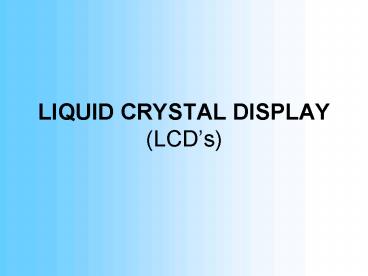LIQUID CRYSTAL DISPLAY LCDs - PowerPoint PPT Presentation
1 / 11
Title:
LIQUID CRYSTAL DISPLAY LCDs
Description:
... and the layers are arranged in a helical, or spiral, fashion. ... Illustration of a simple LCD. A simple LCD display from a calculator. Colored LCD's ... – PowerPoint PPT presentation
Number of Views:17436
Avg rating:3.0/5.0
Title: LIQUID CRYSTAL DISPLAY LCDs
1
LIQUID CRYSTAL DISPLAY (LCDs)
2
- History of LCDs?
- First discovered in 1888, by Austrian botanist
Friedrich Reinitzer. - He melted a curious cholesterol-like substance
(cholesteryl benzoate), it first became a cloudy
liquid and then cleared up as its temperature
rose. Upon cooling, the liquid turned blue before
finally crystallizing. - Eighty years passed before RCA made the first
experimental LCD in 1968.
3
- What are Liquid Crystals
- Liquid crystals are substances that do not melt
directly to the liquid phase but first pass
through a paracrystalline stage in which the
molecules are partially ordered. In this stage a
liquid crystal is a cloudy or translucent fluid
but has some of the optical properties of a solid
crystal. - These are the main elements in a Liquid Crystal
Display
4
- Liquid Crystal Types
- Smectic liquid crystals have molecules parallel
to one another, forming a layer, but within the
layer no periodic pattern exists. - Nematic types have the rod-like molecules
oriented parallel to one another but have no
layer structure. - Cholesteric types have parallel molecules, and
the layers are arranged in a helical, or spiral,
fashion.
5
- Kinds of LCD
- Twisted Nematics (TN)
- A particular liquid crystal used by LCDs is the
liquid crystal, called twisted nematics (TN). - Applying an electric current to these liquid
crystals will untwist them to varying degrees,
depending on the current's voltage. - LCDs use these liquid crystals because they
react predictably to electric current in such a
way as to control light passage.
6
- Supertwist (STN) LCDs
- Although twisted nematic LCDs may be driven in a
time multiplexed fashion to increase the amount
of information displayed, they are restricted in
terms of reduced contrast and limited viewing
angle. - To achieve more highly multiplexed displays,
supertwist technology is employed.
7
- How LCDs work
- LCDs work using these 4 concepts
- Light can be polarized.
- Liquid crystals can transmit and change polarized
light. - The structure of liquid crystals can be changed
by electric current. - There are transparent substances that can conduct
electricity. - An LCD is a device that uses these four facts in
a surprising way!
8
- If we apply an electric charge to liquid crystal
molecules, they untwist! When they straighten
out, they change the angle of the light passing
through them so that it no longer matches the
angle of the top polarizing filter. - Consequently, no light can pass through that area
of the LCD, which makes that area darker than the
surrounding areas.
9
Illustration of a simple LCD
A simple LCD display from a calculator
10
- Colored LCDs
- An LCD that can show colors must have three
subpixels with red, green and blue color filters
to create each color pixel. - Through the careful control and variation of the
voltage applied, the intensity of each subpixel
can range over 256 shades. - Combining the subpixels produces a possible
palette of 16.8 million colors (256 shades of red
x 256 shades of green x 256 shades of blue).
11
Diagram of a colored LCD
- Uses of LCD
- Computers 4. Laptops
- Thermometers 5. Cellphones
- Mood Rings































